


 
 
 
 Photo Essay: Weekend Getaway in Southeast, Part III: SitkaFirst posted in October, 2006 Photo Essay: Weekend Getaway in Southeast, Part III: SitkaFirst posted in October, 2006
 One night in Juneau, then back on the ferry to Sheet'ka: home to the
Kiksadi Tligit, and the former capital of Russian America.
We boarded an early morning ferry (well, it was earlier...
as we would find out in Sitka, ferries can leave *very* early
in the morning indeed.) and headed for the outer coast.
One night in Juneau, then back on the ferry to Sheet'ka: home to the
Kiksadi Tligit, and the former capital of Russian America.
We boarded an early morning ferry (well, it was earlier...
as we would find out in Sitka, ferries can leave *very* early
in the morning indeed.) and headed for the outer coast.
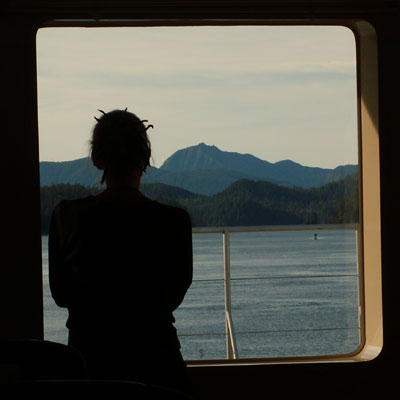 It was a gorgeous day. Miranda and Mash both spent a great
deal of time standing at the front windows of the M/V Fairweather,
waiting for something impressive to happen. And... it did.
It was a gorgeous day. Miranda and Mash both spent a great
deal of time standing at the front windows of the M/V Fairweather,
waiting for something impressive to happen. And... it did.
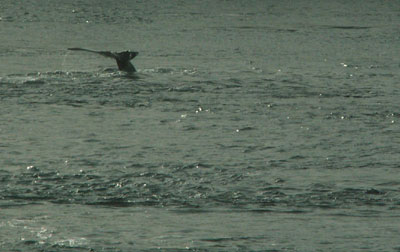 I didn't think that they'd get to see one this time of year, but
Miranda spotted a humpback whale quite near the boat. Most
of them travel to Alaska for the summer to feed on abundant
sources of food, but then winter in Mexico, Hawaii, or in the
western Pacific near the Mariana, Bonin, and Ryukyu islands,
where they mate and have their young. We were very
fortunate indeed to spot one this time of year.
(Considering the fact that there are only an estimated 5,000
to 7,500 such whales in the world, I'm always lucky to see one.)
I arrived just in time to get a rather nice shot of its tail
before a long, deep dive. It did not resurface for us.
We were in a pretty tight channel, and thus very close,
and I wouldn't be surprised if it stayed down for a bit.
I didn't think that they'd get to see one this time of year, but
Miranda spotted a humpback whale quite near the boat. Most
of them travel to Alaska for the summer to feed on abundant
sources of food, but then winter in Mexico, Hawaii, or in the
western Pacific near the Mariana, Bonin, and Ryukyu islands,
where they mate and have their young. We were very
fortunate indeed to spot one this time of year.
(Considering the fact that there are only an estimated 5,000
to 7,500 such whales in the world, I'm always lucky to see one.)
I arrived just in time to get a rather nice shot of its tail
before a long, deep dive. It did not resurface for us.
We were in a pretty tight channel, and thus very close,
and I wouldn't be surprised if it stayed down for a bit.
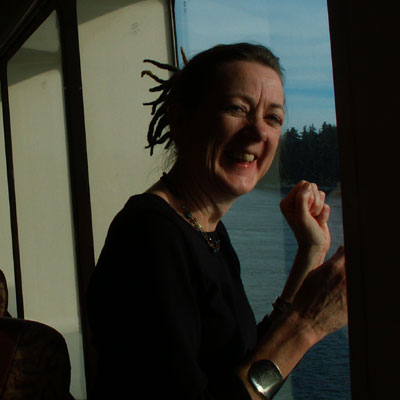 Observe the child-like glee of seeing an endangered whale!
Observe the child-like glee of seeing an endangered whale!
 At any rate, we saw many interesting things, such as a sea otter
that I didn't manage to photograph, and this wrecked barge.
At any rate, we saw many interesting things, such as a sea otter
that I didn't manage to photograph, and this wrecked barge.
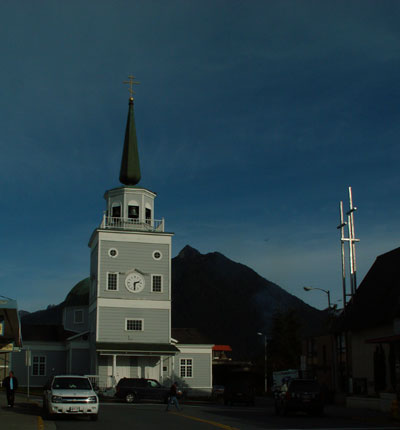 Eventually, after four and a half hours of ferry travel, and an
indescribable amount of logistical hassle in Sitka (should you
take the ferry, I recommend you also take your own car), we
arrived in downtown Sitka and began to explore. Our first
stop was to visit St. Michael's Cathedral on Lincoln Street.
Eventually, after four and a half hours of ferry travel, and an
indescribable amount of logistical hassle in Sitka (should you
take the ferry, I recommend you also take your own car), we
arrived in downtown Sitka and began to explore. Our first
stop was to visit St. Michael's Cathedral on Lincoln Street.
 The cathedral... sort of dates to 1848. That's when it was
dedicated by Bishop Ivan Veniaminov, the "greatest Russian
Orthodox missionary in Alaska." (Remember that name, as it
will come up again later.) In reality, the cathedral burned to
the ground in the early morning hours of January 2, 1966.
Fortunately, though the divine intervention of the Lord our
God and (hooray!) the United States National Park Service,
the building's precise dimensions had been recorded a mere
six months prior to the fire. The building was able to be
rebuilt to exact specifications, having been recorded by the
NPS for inclusion on the National Register of Historic Places
because of its significance in the history of the U.S.
It's a symbol of the Russian influence in Sitka - in
Novoarkhangelsk, or New Arkangel, the former
Russian capital of North America.
The cathedral... sort of dates to 1848. That's when it was
dedicated by Bishop Ivan Veniaminov, the "greatest Russian
Orthodox missionary in Alaska." (Remember that name, as it
will come up again later.) In reality, the cathedral burned to
the ground in the early morning hours of January 2, 1966.
Fortunately, though the divine intervention of the Lord our
God and (hooray!) the United States National Park Service,
the building's precise dimensions had been recorded a mere
six months prior to the fire. The building was able to be
rebuilt to exact specifications, having been recorded by the
NPS for inclusion on the National Register of Historic Places
because of its significance in the history of the U.S.
It's a symbol of the Russian influence in Sitka - in
Novoarkhangelsk, or New Arkangel, the former
Russian capital of North America.
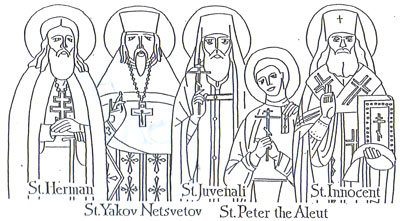 Unfortunately, photographs weren't permitted inside, but we
toured the cathedral, and the woman within, who'd been a
member of the Russian Orthodox Church for fifty years, was
very nice and gave us a lot of information on Alaskan saints
(Herman, Innocent, Juvenali, Peter the Aleut, and Yakov
Netsvetov...let me know if you're curious for more information,
as I have a pamphlet!) and the history of the cathedral.
The domed ceiling of the building was leaking, and the vast
number of Russian Orthodox icons must be difficult to preserve,
so I left a donation. The icons are beautiful, but to be honest,
every time I see wealth displayed in the name of Christianity,
I'm torn between their beauty and significance as art, and
how their value might have been better spent on supporting
the impoverished, as recommended by, you know, Christ.
(Please feel free to read a rant written after I visited
Notre Dame for more on how I feel about this subject.)
Unfortunately, photographs weren't permitted inside, but we
toured the cathedral, and the woman within, who'd been a
member of the Russian Orthodox Church for fifty years, was
very nice and gave us a lot of information on Alaskan saints
(Herman, Innocent, Juvenali, Peter the Aleut, and Yakov
Netsvetov...let me know if you're curious for more information,
as I have a pamphlet!) and the history of the cathedral.
The domed ceiling of the building was leaking, and the vast
number of Russian Orthodox icons must be difficult to preserve,
so I left a donation. The icons are beautiful, but to be honest,
every time I see wealth displayed in the name of Christianity,
I'm torn between their beauty and significance as art, and
how their value might have been better spent on supporting
the impoverished, as recommended by, you know, Christ.
(Please feel free to read a rant written after I visited
Notre Dame for more on how I feel about this subject.)
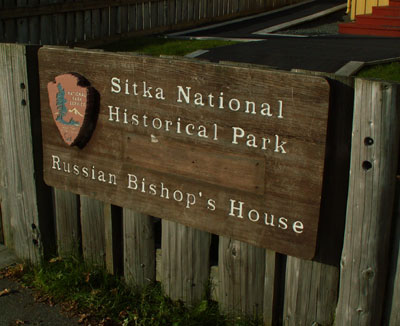 We then made our 3pm appointment (such things have to be
scheduled outside the summer tourist season) with a park ranger
at the Russian Bishop's House for a tour. Bishop Ivan Veniaminov
(perhaps better-known as St. Innocent) came to Alaska in 1834.
His home was completed in 1842. It served as the bishop's home
and, until the cathedral's completion in 1848, as the
Russian Orthodox Church of Sitka.
According to everyone in town, Bishop Innocent "learned the Tlingit
language, and is beloved by the Tlingits as he strove to understand
their way of life and spiritual needs." (According to the handout I was
given at the cathedral, at any rate.) While much is made of how he
learned Tlingit and how he strove to protect the Tlingit from the
unfortunate introduction of European diseases, surprisingly little
mention is made of how the traditional beliefs of the Tlingit were
swept aside, or how Alaska never actually belonged to the
Russians (who thus had no right to sell Alaska to the
United States), or how Christian boarding schools later
contributed to the near-death of the Tlingit language.
We then made our 3pm appointment (such things have to be
scheduled outside the summer tourist season) with a park ranger
at the Russian Bishop's House for a tour. Bishop Ivan Veniaminov
(perhaps better-known as St. Innocent) came to Alaska in 1834.
His home was completed in 1842. It served as the bishop's home
and, until the cathedral's completion in 1848, as the
Russian Orthodox Church of Sitka.
According to everyone in town, Bishop Innocent "learned the Tlingit
language, and is beloved by the Tlingits as he strove to understand
their way of life and spiritual needs." (According to the handout I was
given at the cathedral, at any rate.) While much is made of how he
learned Tlingit and how he strove to protect the Tlingit from the
unfortunate introduction of European diseases, surprisingly little
mention is made of how the traditional beliefs of the Tlingit were
swept aside, or how Alaska never actually belonged to the
Russians (who thus had no right to sell Alaska to the
United States), or how Christian boarding schools later
contributed to the near-death of the Tlingit language.
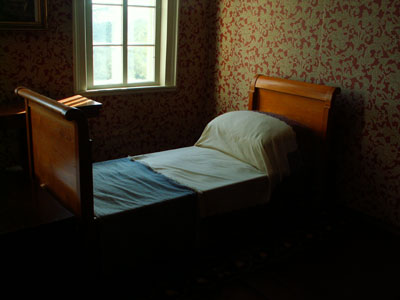 But I digress. Did you know that Bishop Innocent was actually
quite tall, and yet he, like many of the period, slept in one
of these cramped little beds (pictured above)? Turns out they
thought that sleeping while sitting up would protect them from
the lung ailment du jour!
Anyway, all kidding aside (though the bit about him being tall and
sleeping upright is true... honest), the house is very interesting.
It has double-layered floors filled with sand and rock for insulation,
and the ends of the house contain stairwells that are blocked off
from the core to prevent cold air from moving down to the first floor.
And the aforementioned bed? St. Innocent built that himself.
He was a carpenter, just like Jesus.
But I digress. Did you know that Bishop Innocent was actually
quite tall, and yet he, like many of the period, slept in one
of these cramped little beds (pictured above)? Turns out they
thought that sleeping while sitting up would protect them from
the lung ailment du jour!
Anyway, all kidding aside (though the bit about him being tall and
sleeping upright is true... honest), the house is very interesting.
It has double-layered floors filled with sand and rock for insulation,
and the ends of the house contain stairwells that are blocked off
from the core to prevent cold air from moving down to the first floor.
And the aforementioned bed? St. Innocent built that himself.
He was a carpenter, just like Jesus.
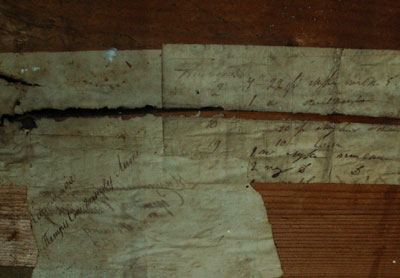 All kidding about the kidding aside (except he really was a carpenter...
honest), the previous photograph is of how paper was so precious
that left-over scraps were used to stop cold air between the logs
of the home. I realize that a couple of people reading this might
speak fluent Russian, so if you want to see this at full size, click here.
All kidding about the kidding aside (except he really was a carpenter...
honest), the previous photograph is of how paper was so precious
that left-over scraps were used to stop cold air between the logs
of the home. I realize that a couple of people reading this might
speak fluent Russian, so if you want to see this at full size, click here.
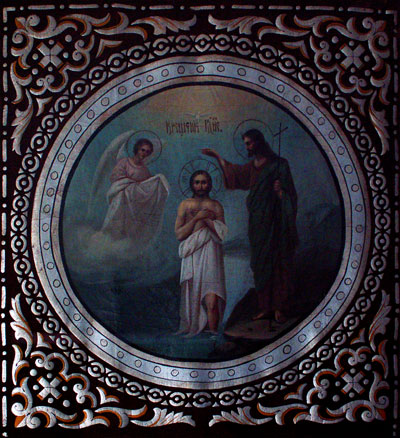 While we weren't able to photograph inside the cathedral,
we were permitted to photograph inside the bishop's
house, including icons seen within the house's chapel.
While we weren't able to photograph inside the cathedral,
we were permitted to photograph inside the bishop's
house, including icons seen within the house's chapel.
 I've prattled on enough that I should probably
just post some images...
I've prattled on enough that I should probably
just post some images...
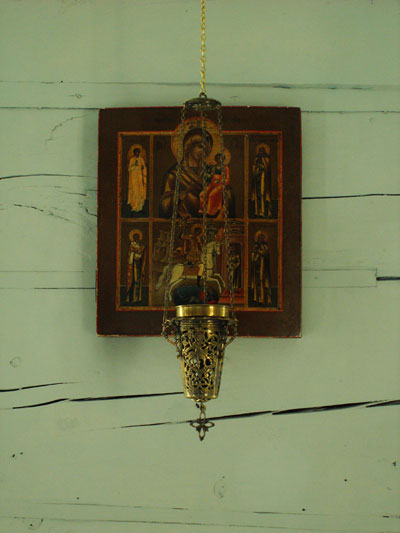 Another image of an icon with a censer in front of it.
Another image of an icon with a censer in front of it.
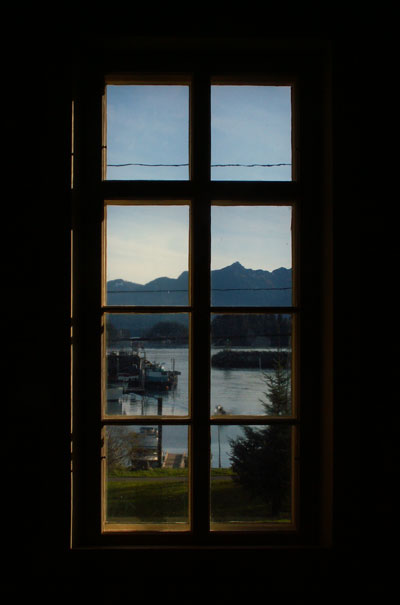 We eventually looked out the window of St. Innocent's house,
toward Sitka. And decided it was time to see some more of it.
We eventually looked out the window of St. Innocent's house,
toward Sitka. And decided it was time to see some more of it.
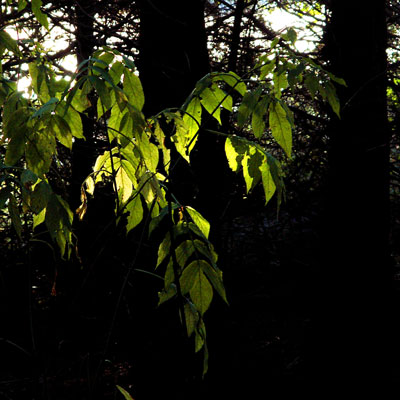 We visited the amazing (and rather new) visitor center of Sitka
National Historical Park, where I caught up with some other rangers
(and thus utterly failed to take even a single photograph...),
then we wandered out onto the trails surrounding the park.
We visited the amazing (and rather new) visitor center of Sitka
National Historical Park, where I caught up with some other rangers
(and thus utterly failed to take even a single photograph...),
then we wandered out onto the trails surrounding the park.
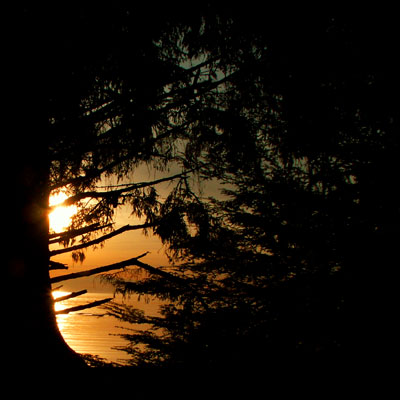 Mash, fond of tinkering and woodworking, was quickly lost in
conversation with a Tlingit woodcarver. The rest of us moved
on down the trail, racing through the woods against sunset.
Mash, fond of tinkering and woodworking, was quickly lost in
conversation with a Tlingit woodcarver. The rest of us moved
on down the trail, racing through the woods against sunset.
 This is a Tlingit mortuary pole, a sort of totem pole raised
to honor the dead. Often, cremains are contained within.
The single figure at the top represents the person's clan
or moiety. The figure, in this case, is a raven.
This is a Tlingit mortuary pole, a sort of totem pole raised
to honor the dead. Often, cremains are contained within.
The single figure at the top represents the person's clan
or moiety. The figure, in this case, is a raven.
 Here, Sam admires a totem pole that
explains the legend of the mosquito:
An unusual child with arrow points on his head was born to a chief's daughter.
One day the mother angered the child, and he killed her by driving the sharp
points into her breasts. Afterward he fled into the woods, where he continued
to kill other villagers out hunting or collecting wood. One of the village men -
the boy's uncle - finally managed to trap and kill him. The boy's body was
burned, leaving only ashes. When the ashes were driven about by the
wind, they became mosquitoes that still torment people today.
Here, Sam admires a totem pole that
explains the legend of the mosquito:
An unusual child with arrow points on his head was born to a chief's daughter.
One day the mother angered the child, and he killed her by driving the sharp
points into her breasts. Afterward he fled into the woods, where he continued
to kill other villagers out hunting or collecting wood. One of the village men -
the boy's uncle - finally managed to trap and kill him. The boy's body was
burned, leaving only ashes. When the ashes were driven about by the
wind, they became mosquitoes that still torment people today.
 The day came to a close, with just enough time for a few
photographs before leaving the park and
returning to our hotel.
Above, sunset...
The day came to a close, with just enough time for a few
photographs before leaving the park and
returning to our hotel.
Above, sunset...
 ...a fishing boat returning to harbor before nightfall...
...a fishing boat returning to harbor before nightfall...
 ...birds taking flight after being roused
by a walker and his dog...
...birds taking flight after being roused
by a walker and his dog...
 ...and a sailboat floating past the bridge
to the airport and Mt. Edgecombe,
Sitka's neighborhood volcano.
We returned to our very lovely hotel, the Cascade Inn, which is complete with
oceanfront sauna (the glass in it fogs up, of course, once you throw water on the
heat, but it's a romantic idea nonetheless, and the proprietors are quite helpful).
At three in the morning, I woke everyone else up for the journey home.
...and a sailboat floating past the bridge
to the airport and Mt. Edgecombe,
Sitka's neighborhood volcano.
We returned to our very lovely hotel, the Cascade Inn, which is complete with
oceanfront sauna (the glass in it fogs up, of course, once you throw water on the
heat, but it's a romantic idea nonetheless, and the proprietors are quite helpful).
At three in the morning, I woke everyone else up for the journey home.
[ TOP OF THIS PAGE | MORE PHOTOGRAPHY | MORE WRITING | HOME ]


|









